
The Doors were an American rock band formed in Los Angeles in 1965, comprising vocalist Jim Morrison, keyboardist Ray Manzarek, guitarist Robby Krieger and drummer John Densmore. They were among the most influential and controversial rock acts of the 1960s, primarily due to Morrison's lyrics and voice, along with his erratic stage persona and legal issues. The group is widely regarded as an important figure of the era's counterculture.
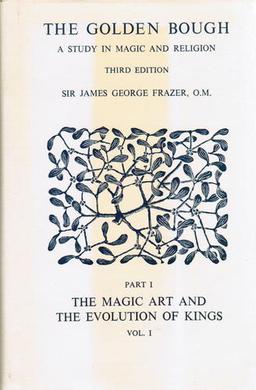
The Golden Bough: A Study in Comparative Religion is a wide-ranging, comparative study of mythology and religion, written by the Scottish anthropologist Sir James George Frazer. The Golden Bough was first published in two volumes in 1890; in three volumes in 1900; and in twelve volumes in the third edition, published 1906–1915. It has also been published in several different one-volume abridgments. The work was for a wide literate audience raised on tales as told in such publications as Thomas Bulfinch's The Age of Fable, or Stories of Gods and Heroes (1855). The influence of The Golden Bough on contemporary European literature and thought was substantial.

Waiting for the Sun is the third studio album by the American rock band the Doors, released by Elektra Records on July 3, 1968. The album's 11 tracks were recorded between late 1967 and May 1968 mostly at TTG Studios in Los Angeles. It became the band's only number one album, topping the Billboard 200 for four weeks, while also including their second US number one single, "Hello, I Love You". The first single released off the record was "The Unknown Soldier", which peaked at number 39 on the Billboard Hot 100. It also became the band's first hit album in the UK, where it reached number 16.
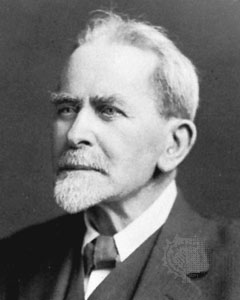
Sir James George Frazer was a Scottish social anthropologist and folklorist influential in the early stages of the modern studies of mythology and comparative religion.

The Soft Parade is the fourth studio album by American rock band the Doors, released on July 18, 1969, by Elektra Records. Most of the album was recorded following a grueling tour during which the band was left with little time to compose new material. Record producer Paul A. Rothchild recommended a total departure from the Doors' first three albums: develop a fuller sound by incorporating brass and string arrangements provided by Paul Harris. Lead singer Jim Morrison, who was dealing with personal issues and focusing more on his poetry, was less involved in the songwriting process, allowing guitarist Robby Krieger to increase his own creative output.
"Celebration of the Lizard" is a performance piece by American rock band the Doors, featuring lyrics written by lead singer Jim Morrison and music by the Doors. Composed as a series of poems, the piece includes both spoken verse and sung lyrics, musical sections, interpretive dance, audience reaction, and passages of allegorical storytelling, though the Doors often performed abridged renditions which omitted some or even most these elements.

"Touch Me" is a song by the Doors from their 1969 album The Soft Parade. Written by guitarist Robby Krieger in late 1968, it makes extensive use of brass and string instruments, including a solo by featured saxophonist Curtis Amy.

Butterfly is the seventh UK studio album by British band the Hollies, released in November 1967. It was the final Hollies album to feature Graham Nash before his departure from the group in 1968. The album consisted solely of songs written by the trio of Nash, Allan Clarke, and Tony Hicks, with Nash leading the sessions. It showcased the band's pop-oriented approach to psychedelia.

"The Crystal Ship" is a song by American rock band the Doors, from their 1967 debut album The Doors, and the B-side of the number-one hit single "Light My Fire". It was composed as a love song to Jim Morrison's first serious girlfriend, Mary Werbelow, shortly after their relationship ended.

Legacy: The Absolute Best is a two-disc compilation album by American rock band the Doors. Released in 2003, it includes the uncensored versions of both "Break On Through " and "The End". Also included is a previously unreleased studio version of Morrison's epic poetry piece "Celebration of the Lizard," a rehearsal outtake from the band's Waiting for the Sun sessions.

"Monday, Monday" is a 1966 song written by John Phillips and recorded by the Mamas & the Papas, using background instruments played by members of the Wrecking Crew for their 1966 album If You Can Believe Your Eyes and Ears. Denny Doherty was the lead vocalist. It was the group's only #1 hit on the U.S. Billboard Hot 100.
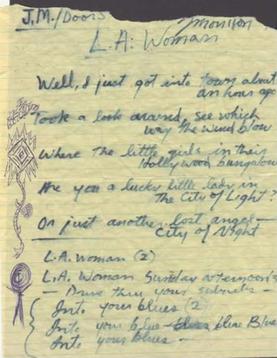
"L.A. Woman" is a song by the American rock band the Doors. The song is the title track of their 1971 album L.A. Woman, the final album to feature Jim Morrison before his death on July 3, 1971. In 2014, LA Weekly named it the all-time best song written about the city of Los Angeles.

"Love in an Elevator" is a song performed by American rock band Aerosmith, written by Steven Tyler and Joe Perry. It was released in August 1989 as the lead single from their third album with Geffen Records, Pump, released in September. It peaked at No. 5 on the Billboard Hot 100 and reached No. 1 on the Hot Mainstream Rock Tracks chart. The RIAA certified it gold.

The Black-Man's Burdon is a double album by American band Eric Burdon and War, released in December 1970 on MGM Records. It was the last album by the group before Burdon left and the remaining band continued as War.

"Heartache Tonight" is a song written by Don Henley, Glenn Frey, Bob Seger and J. D. Souther, recorded by the Eagles and features Glenn Frey on lead vocals. The track was included on their album The Long Run and released as a single in 1979. It reached No. 1 on the U.S. Billboard Hot 100 in November of that year and was certified Platinum by the Recording Industry Association of America representing one million copies sold. It was the Eagles' final chart-topping song on the Hot 100.
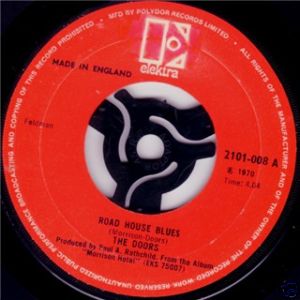
"Roadhouse Blues" is a song by the American rock band the Doors from their 1970 album Morrison Hotel. It was released as the B-side of "You Make Me Real", which peaked at No. 50 on the U.S. Billboard Hot 100 and No. 41 in Canada. "Roadhouse Blues" charted in its own right on the Cash Box Top 100, peaking at No. 76. The song became a concert staple for the group and it has been covered by numerous artists.
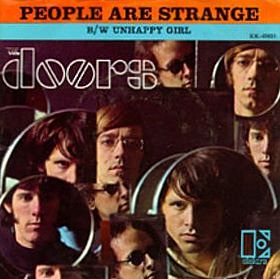
"People Are Strange" is a song by the American rock band the Doors. It appears on the band's second studio album, Strange Days, released in September 1967. The song was written by the Doors' vocalist Jim Morrison and guitarist Robby Krieger, although all of the band are credited on the sleeve notes.
"The Soft Parade" is a song composed by the American rock group the Doors, though credited to lead singer Jim Morrison only. It was recorded for their fourth studio album, also titled The Soft Parade (1969), appearing as the closing track. It has been considered as one of the most musically diverse compositions by the band.

Perception is a 12-disc box set by American rock band the Doors. The CDs contain the six 1999 remastered versions of the Doors' six studio albums plus DVD-Audio discs containing the 2007 40th anniversary stereo and surround remixes of those albums as well as visual extras. Each album includes extra tracks consisting of previously unreleased session outtakes. Exclusive to the box set is a DVD with several live performances and other extras. The title is derived from Aldous Huxley's book The Doors of Perception, which inspired the band's name.

"A Face in the Crowd" is a song co-written and recorded by Tom Petty. It was released in February 1990 as the fourth single from his first solo album Full Moon Fever. It peaked at number 46 on the U.S. Billboard Hot 100 chart.

















